Steinberg Dorico Operation Manual
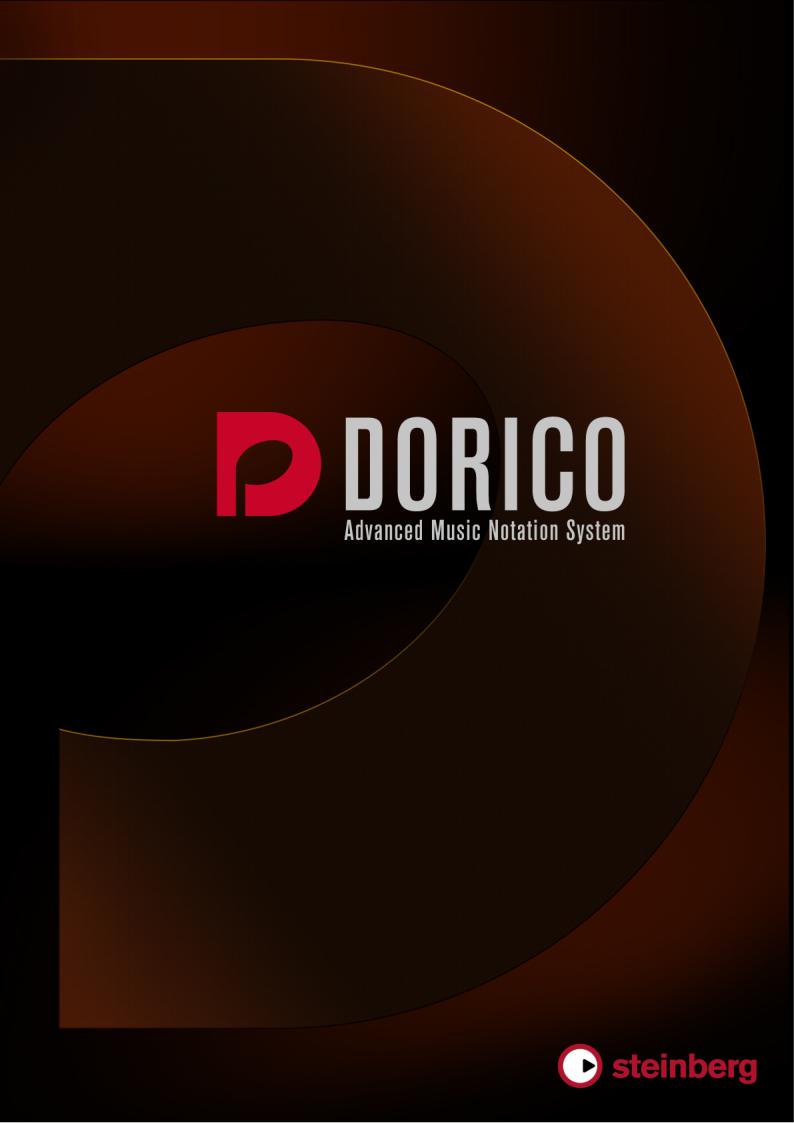
Operation Manual
Daniel Spreadbury
Cristina Bachmann, Heiko Bischoff, Christina Kaboth, Insa Mingers, Matthias Obrecht, Sabine Pfeifer, Benjamin Schütte, Marita Sladek
This PDF provides improved access for vision-impaired users. Please note that due to the complexity and number of images in this document, it is not possible to include text descriptions of images.
The information in this document is subject to change without notice and does not represent a commitment on the part of Steinberg Media Technologies GmbH. The software described by this document is subject to a License Agreement and may not be copied to other media except as specifically allowed in the License Agreement. No part of this publication may be copied, reproduced, or otherwise transmitted or recorded, for any purpose, without prior written permission by Steinberg Media Technologies GmbH. Registered licensees of the product described herein may print one copy of this document for their personal use.
All product and company names are ™ or ® trademarks of their respective owners. For more information, please visit www.steinberg.net/trademarks.
© Steinberg Media Technologies GmbH, 2017. All rights reserved.

Table of Contents
4 Introduction
4Platform-Independent Documentation
4Usage of Musical Terms
5Conventions
9 How You Can Reach Us
11 First Steps
11 Getting Around
18 Starting a New Project
21 Writing Music
26Dorico Concepts
26Design Philosophy
27Key Musical Concepts
31 |
User Interface |
31 |
Hub |
34 |
Windows |
44 |
Setting up Your Workspace |
53 |
Setup Mode |
53 |
Project Window in Setup Mode |
58 |
Players |
63 |
Ensembles |
63 |
Instruments |
65 |
Groups |
67 |
Flows |
69 |
Layouts |
74 |
Write Mode |
74 |
Project Window in Write Mode |
79 |
Note Input |
112 |
Engrave Mode |
112 |
Project Window in Engrave Mode |
117 |
Master Pages |
126 |
Frames |
143 |
Properties in Engrave Mode |
154 Print Mode
154 Project Window in Print Mode
157 Printing Your Layouts
160 Exporting Your Layouts as Graphic Files
162 Printing/Exporting Multiple Layouts
162Layout Page Arrangements for Printing/ Exporting
164Handling Page Sizes and Paper Sizes
165Annotations
167 |
Notation Reference |
167 |
Spaces |
167 |
Stems |
169 |
Accidentals |
175 |
Articulations |
180Time Signatures
181Ties
185 Lyrics
187 Index
3

Introduction
Thank you very much for purchasing Dorico.
We are delighted that you have chosen Steinberg's new scoring application and hope that you will enjoy using it for years to come.
Dorico is a next-generation application for producing beautiful sheet music, whether you are a composer, arranger, music engraver, publisher, instrumentalist, teacher, or student. Whether you want to print your music or share it in a digital format, Dorico is the most sophisticated program available.
Like all of Steinberg's products, Dorico has been designed from the ground up by a team of musicians who understand your needs and who are dedicated to producing a tool that is both easy to learn and use, but also capable of results of the highest quality. Dorico also
integrates with your existing workflow and can import and export files in a variety of formats.
Dorico thinks about music the same way a human musician does and has a deeper understanding of the elements of music and musical performance than other scoring applications. Its unique design allows an unprecedented degree of flexibility, in music input and editing, in score layout, in rhythmic freedom, and many other areas besides.
Most sincerely yours,
Your Steinberg Dorico Team
Platform-Independent Documentation
The documentation applies to the operating systems Windows and macOS.
Features and settings that are specific to one of these platforms are clearly indicated. In all other cases, the descriptions and procedures in the documentation are valid for Windows and macOS.
Some points to consider:
•The screenshots are taken from Windows.
•Some functions that are available on the File menu on Windows can be found in the program name menu on macOS.
Usage of Musical Terms
This documentation uses American terminology for musical items throughout the documentation.
The following table lists all the notes and notations that have different names in American and British English:
4

Introduction
Conventions
|
American Name |
British Name |
|
|
Double whole note |
Breve |
|
|
Whole note |
Semibreve |
|
|
Half note |
Minim |
|
|
Quarter note |
Crotchet |
|
|
Eighth note |
Quaver |
|
|
Sixteenth note |
Semiquaver |
|
|
Thirty-second note |
Demisemiquaver |
|
|
Sixty-fourth note |
Hemidemisemiquaver |
|
|
Hundred twenty-eighth note |
Semihemidemisemiquaver |
|
|
Two hundred fifty-sixth note |
Demisemihemidemisemiquaver |
|
|
Staff |
Stave |
|
|
Bar/Measure |
Bar |
|
|
|
|
|
|
NOTE |
|
|
|
This documentation only uses “bar”. |
|
|
|
|
|
|
|
|
|
|
Conventions
In our documentation, we use typographical and markup elements to structure information.
Typographical Elements
The following typographical elements mark the following purposes.
PREREQUISITE
Requires you to complete an action or to fulfill a condition before starting a procedure.
PROCEDURE
Lists the steps that you must take to achieve a specific result.
IMPORTANT
Informs you about issues that might affect the system, the connected hardware, or that might bring a risk of data loss.
5

Introduction
Conventions
NOTE
Informs you about issues that you should consider.
EXAMPLE
Provides you with an example.
RESULT
Shows the result of the procedure.
AFTER COMPLETING THIS TASK
Informs you about actions or tasks that you can undertake after completing the procedure.
RELATED LINKS
Lists related topics that you can find in this documentation.
Markup
Elements of the user interface are highlighted throughout the documentation. Names of menus, options, functions, dialogs, windows, etc. are highlighted in bold.
EXAMPLE
To open notation options in Write mode, select Write > Notation Options.
If bold text is separated by a greater-than symbol, this indicates a sequence of different menus to open.
EXAMPLE
Select Engrave > Engraving Options.
File names and folder paths are highlighted in Courier typeface.
Key Commands
Many of the default key commands, also known as keyboard shortcuts, use modifier keys, some of which are different depending on the operating system.
For example, the default key command for Undo is Ctrl-Z on Windows and Cmd-Z on macOS. When key commands with modifier keys are described in this manual, they are shown with the Windows modifier key first, in the following way:
•Windows modifier key/macOS modifier key-key
EXAMPLE
Ctrl/Cmd-Z means: press Ctrl on Windows or Cmd on macOS, then press Z.
6

Introduction
Conventions
Key Commands in Dorico
The default key commands in Dorico depend on your keyboard layout.
If you move the mouse over a tool or a function, the information in brackets shows the key command that is used to activate or deactivate a tool or a function.
You can also do one of the following:
•Open the Dorico Key Commands window that provides an overview of all available key commands.
•Search for key commands of specific functions or menu items in the Preferences dialog. In this dialog, you can also assign new key commands or change default key commands.
RELATED LINKS
Dorico Key Commands Window on page 7
Searching for Key Commands of Functions on page 8
Dorico Key Commands Window
The Dorico Key Commands window shows a virtual computer keyboard. Depending on the selected keyboard layout that you have selected in the Preferences dialog, it highlights the keys that have been assigned key commands. Below the virtual computer keyboard, all key commands are listed.
To access the Dorico Key Commands window, do one of the following:
•Select Help > Key Commands.
•Select Edit > Preferences, and in the Preferences dialog, in the Key Commands section, click Print Summary.
The Dorico Key Commands window opens in a web browser. You have the following options:
•To see the available key commands, select a context. The context of a key command is the mode in which it can be used. Key commands that have a global context work in all modes.
•To highlight the keys that you can press in combination with the modifier key to form a key command, press a modifier key on your computer keyboard, such as Shift. You can also press more than one modifier key. The virtual computer keyboard shows the highlighted keys and displays on each key to which functions it is assigned.
NOTE
You can also use the mouse to select a modifier key on the virtual computer keyboard.
•To search for a specific key command, enter one or multiple words in the search input field.
•To get an overview of all available key commands, browse the key commands that are listed below the virtual keyboard. The key commands are listed according to the context in which they can be used.
7

Introduction
Conventions
Searching for Key Commands of Functions
You can search for key commands that are assigned to functions or menu items in Dorico. NOTE
You can also search for functions in the Dorico Key Commands window.
PROCEDURE
1.Select Edit > Preferences.
2.In the Key Commands section, in the Search field, enter the name of a function. The entries that are listed below are filtered according to the words that you enter.
3.Expand an entry and select the function for which you want to see the key command.
RESULT
If the function has a key command, it is shown in the Assigned key commands display.
RELATED LINKS
Dorico Key Commands Window on page 7
Changing the Keyboard Layout
You can change the keyboard layout in Dorico. This allows you to use the pre-defined key commands for your language.
PROCEDURE
1.Select Edit > Preferences.
2.In the Key Commands section, from the Keyboard language pop-up menu, select a different keyboard layout.
3.Click Apply.
RESULT
You can immediately use the available key commands for your language.
Assigning Key Commands
You can assign key commands to Dorico functions that have no key commands assigned. You can also change existing key commands.
PROCEDURE
1.Select Edit > Preferences.
2.In the Key Commands section, search for the name of a function and select it.
3.Optional: Press Remove Key Command if the function is already assigned a key command.
NOTE
If you assign a new key command without removing an existing one, you will be able to use either key command.
4.Click in the New key command input field.
8

Introduction
How You Can Reach Us
5.On your computer keyboard, press the key command that you want to assign.
6.Click Add Key Command.
The key command is shown in the Assigned key commands display.
7.Click Apply.
RESULT
You can immediately use the assigned key command.
RELATED LINKS
Searching for Key Commands of Functions on page 8
Resetting Key Commands on page 9
Removing Key Commands
You can remove assigned key commands from a function.
PROCEDURE
1.Select Edit > Preferences.
2.In the Key Commands section, search for the name of a function and select it.
3.Click Remove Key Command.
4.Click Apply.
RESULT
The key command is removed from the selected function.
RELATED LINKS
Searching for Key Commands of Functions on page 8
Resetting Key Commands on page 9
Resetting Key Commands
You can reset all key commands to their defaults.
PROCEDURE
1.Select Edit > Preferences.
2.In the Key Commands section, click Reset Key Commands.
3.Click OK.
RESULT
All custom key commands are deleted and the default key commands are reinstated.
How You Can Reach Us
On the Help menu you find items linking to additional information.
The menu contains links to various Steinberg web pages. Selecting one of these menu items automatically launches your web browser and opens the page. On these pages, you can find support and compatibility information, answers to frequently asked questions, information
9

Introduction
How You Can Reach Us
about updates and other Steinberg products, etc. This requires that you have a web browser installed on your computer and a working Internet connection.
10

First Steps
This chapter helps you to get started with Dorico.
When you start Dorico for the first time, we recommend that you open one of the templates first to have a look at the user interface and the functions that Dorico provides before you start your own projects. You are welcome to skip this part and explore the program for yourself.
The following sections inform you about the following topics:
•Overview of the most important workspaces
•Setting up a new project
•Writing your music and adding notation items to your score
•Laying out and formatting pages
•Playing back what you created
•Printing and exporting
Getting Around
The following sections give you an overview of the user interface and introduce you to how Dorico is structured.
Opening a Template
Before you start your own project, we recommend that you familiarize yourself with the user interface of Dorico. To prepare for this, open one of the templates that are provided with the program.
PREREQUISITE
You have started Dorico. The Hub is open.
PROCEDURE
1.In the Hub, select one of the listed template groups, for example the Choral and Vocal templates.
2.Select one of the listed templates.
11
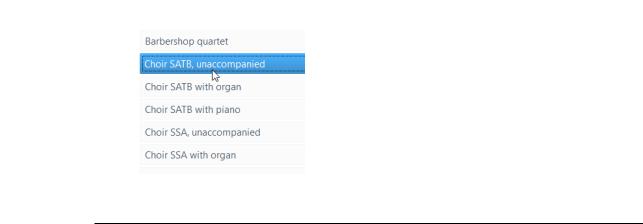
First Steps
Getting Around
3.Click New from Template.
RESULT
The template opens.
AFTER COMPLETING THIS TASK
Proceed to the following sections that provide a quick overview of the user interface and that introduce you to the main functions of the program.
RELATED LINKS Hub on page 31
Quick Tour of the User Interface
The user interface of Dorico consists of different modes that represent different phases in the workflow of preparing a score.
The user interface has a structure that is the same in each of the application’s modes. There is always a large area for editing your music in the center of the project window. In every mode, there are collapsible panels on the left, right, and bottom of the project window, depending on which mode you are using. The contents of these panels change according to the selected mode.
When you open the template, the first view shows the project window in Write mode:
12
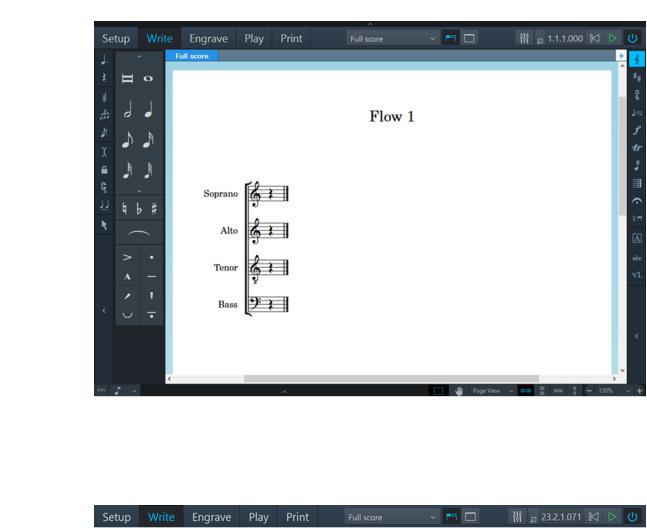
First Steps
Getting Around
The project window contains the following areas:
Toolbar
The toolbar is located at the top of the project window.
On the left side of the toolbar, the modes are displayed. By activating a mode, you change the workspace and the available panels. The active mode is highlighted in a different color. In the middle of the toolbar, layout options allow you to switch between the different layouts in your project and to show/hide panels and tabs. On the right side of the toolbar, you can open a
Mixer  and activate basic transport controls that, among other functions, allow you to play back and record your music.
and activate basic transport controls that, among other functions, allow you to play back and record your music.
Music Area
The music area is the main part of the project window in Setup, Write, and Engrave mode where you set up, input, edit and format your music. In Play mode, this area is called event display, in which every note is displayed as an event. In Print mode, this area is called print preview area, which shows a preview of what is going to be printed or exported as a graphic.
13

First Steps
Getting Around
The music area displays the scores or the instrumental parts that you create. On top of the music area you can activate several layouts in tabs and switch between them. Layouts in Dorico allow you to show different presentations of your music. If you have a full score with different instrumental parts, such as a violin part and a bassoon part, you can switch
between the full score layout and the layouts of each part. To save space on the screen or to focus on a specific layout, you can hide the tabs.
Toolboxes
In Write mode, there are additional columns at the left and right edges of the project window. These are called toolboxes.
Notes toolbox in Write mode
Notations toolbox in Write mode
14
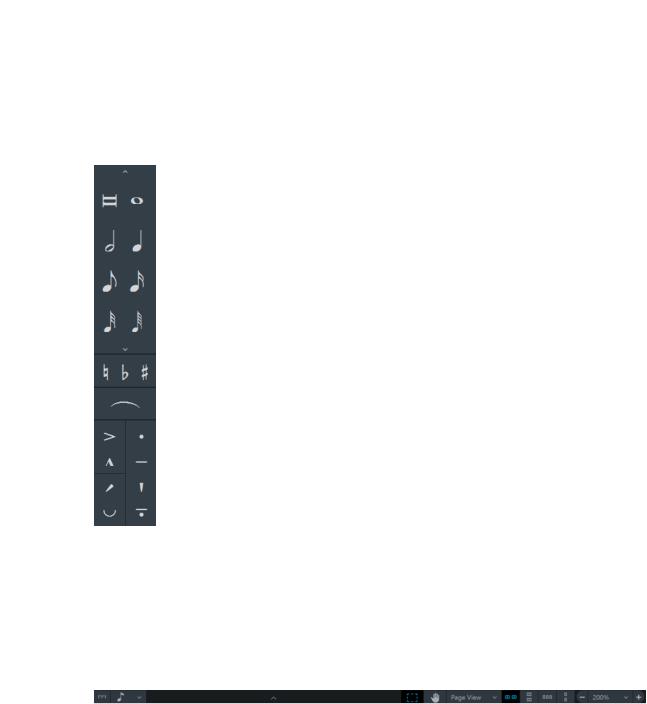
First Steps
Getting Around
The notes toolbox on the left allows you to activate or deactivate various note input tools. The notations toolbox on the right provides tools that allow you to create and edit other notations, such as clefs, key signatures, time signatures, etc.
Panels
Dorico provides panels with various functions in all modes. When you open the template, there is a panel on the left of the music area. This is the notes panel in Write mode.
Notes panel in Write mode
The notes panel contains all the durations, accidentals, slurs, and articulations that are most commonly used when inputting notes.
Status Bar
At the bottom of the project window, a status bar allows you to select different views and page arrangements for the music area.
RELATED LINKS
Functions of the Modes on page 15
User Interface on page 31
Functions of the Modes
Modes represent different phases in the workflow of preparing a score. By activating a mode, you change the workspace and the available panels.
15

First Steps
Getting Around
Setup Mode
In Setup mode, you can create players, groups of players, and assign instruments to them. You can define different layouts for your project that you can print or export independently. For example, you can print or export a layout for the full score and separate layouts for each instrumental part.
Write Mode
In Write mode, you can input your music. The available toolboxes and panels allow you to input all the notes and notation items that are most commonly used.
Engrave Mode
In Engrave mode, you can make fine adjustments to the music that you input in Write mode and determine how the pages of your project are laid out.
Play Mode
In Play mode, you can assign virtual instruments and effects for playback to instruments and playing techniques. You can make adjustments to how individual notes are played back in order to produce a more realistic performance.
Print Mode
In Print mode, you can print your layouts or export them as graphic files.
Hiding/Restoring Panels
You can hide and show individual or multiple panels. This is useful if you want to see more of the music area, for example.
PROCEDURE
•Do one of the following:
•To show/hide the left panel, click its disclosure arrow or select Window > Show Left Panel.
•To show/hide the right panel, click its disclosure arrow or select Window > Show Right Panel.
•To show/hide the bottom panel, click its disclosure arrow or select Window >
Show Bottom Panel.
•To show/hide all panels, click Hide/Restore Panels  or select Window > Hide/ Restore Panels.
or select Window > Hide/ Restore Panels.
RESULT
If you hide all active panels, the button changes its look and displays which panels are hidden. For example, the following button indicates that all panels were active and are now
hidden:  .
.
Working with Tabs and Windows
Dorico enables you to set up your workspace according to your working style.
16
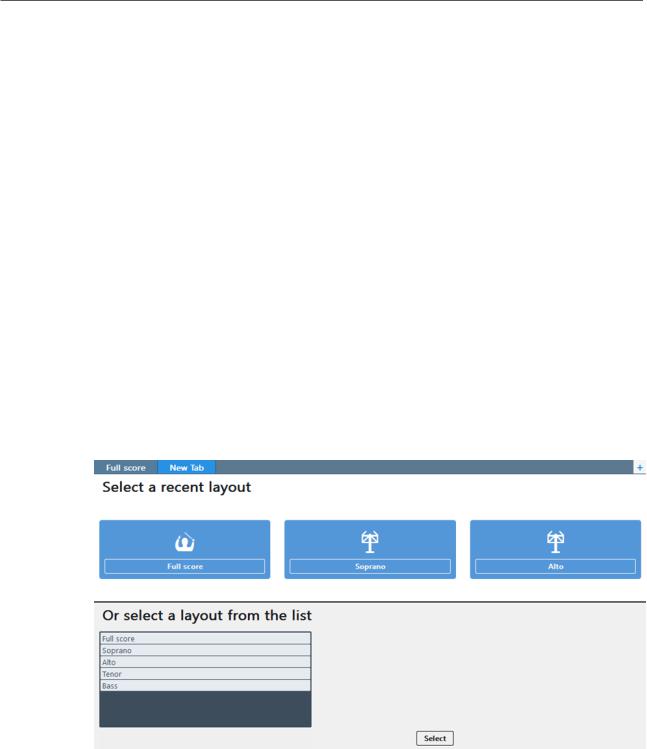
First Steps
Getting Around
Dorico allows you to open multiple tabs to display multiple layouts in the same project within the same window. You can also open the same project in several windows.
RELATED LINKS
Setting up Your Workspace on page 44
Opening a New Tab
You can open a new tab to display a different view or layout within the same project window.
Each tab can contain a separate layout or an additional view of a layout that is already open in another tab or window. Whenever you open a new tab, you are prompted to select a layout that you want to display in the tab.
You can find the tabs at the top of the music area, below the toolbar. If you do not see the tabs, click Show Tabs  in the toolbar.
in the toolbar.
PROCEDURE
•To open a new tab, do one of the following:
•Press Ctrl/Cmd-T.
•To the right of the tabs, click New Tab  .
.
RESULT
A new tab opens that shows several icons at the top and a list of layouts at the bottom.
AFTER COMPLETING THIS TASK
You can click one of the icons or select a layout from the list at the bottom. Alternatively, you can click Select Layout on the toolbar and choose one of the layouts from the pop-up menu. The layout that you choose opens in the active tab.
Opening a New Window
You can open another window for the same project.
17

First Steps
Starting a New Project
This may be useful if you want to see and work on multiple layouts at the same time. You can also open multiple project windows to show different modes of the same project.
PROCEDURE
•Do one of the following:
•Press Ctrl/Cmd-Shift-T.
•Select Window > New Window.
RESULT
A duplicate of the window opens. It contains the same tabs and the same view options as the original window.
RELATED LINKS
Opening Multiple Project Windows on page 47
Starting a New Project
After getting a first impression of the Dorico user interface you may want to get started with inputting your own music. In this section, you learn how to set up a new project.
PREREQUISITE NOTE
All inputs that are made and the images that are used to accompany the steps in this chapter are intended merely to be helpful examples. Therefore, there is no need to make the exact same entries in order to get the depicted results.
Close the template without saving. The Hub reopens.
PROCEDURE
•Do one of the following:
•Select New Empty Project.
•Press Ctrl/Cmd-N
RESULT
A new project window opens.
18
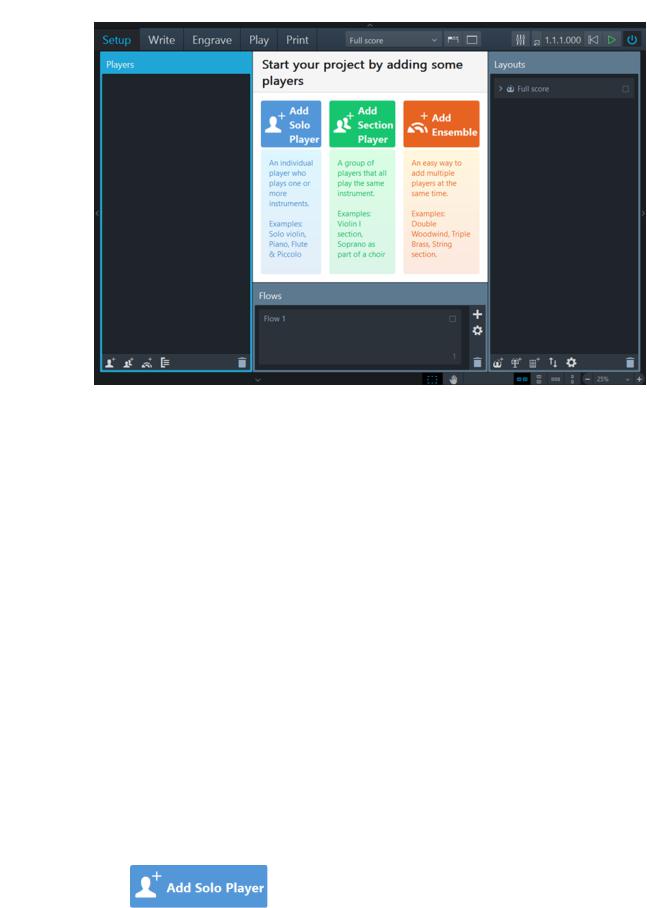
First Steps
Starting a New Project
Whenever you start a new project without selecting a specific project template, Setup mode is activated. This allows you to specify players and assign instruments right from the start. The area in the middle, the project start area, which becomes the music area once you have added a player, allows you to start your project with different types of players. On the right, the Layouts panel shows a Full score entry. This entry is available in every new project. At the bottom of the window is the Flows panel where you can specify separate spans of music for your project.
AFTER COMPLETING THIS TASK
Start your project by adding an individual player or by adding a section player and assign an instrument. You are free to assign any kind of instrument. In this chapter, only one piano player is added as an example.
RELATED LINKS Windows on page 34 Flows on page 29
Adding a Solo Player
In this section, you learn how to add a player and assign an instrument. PREREQUISITE
You have started a new project. You are in Setup mode.
PROCEDURE
1.Click Add Solo Player.
This adds an empty-handed player on the Players panel.
19

First Steps
Starting a New Project
2.In the popover, select an instrument.
NOTE
For this example, select the piano player. TIP
•You can use the search field of the popover and start entering the name of the instrument. The list automatically filters the names while you type.
•You can also open the popover by clicking the plus symbol  to the right of the added empty-handed player. Alternatively, you can right-click the player and select Add Instrument to Player.
to the right of the added empty-handed player. Alternatively, you can right-click the player and select Add Instrument to Player.
3.Click Add.
RESULT
You have added your first player. In the music area, the required piano staves including their respective clefs are displayed.
AFTER COMPLETING THIS TASK Save your project.
NOTE
You can save your project at any time.
Optionally, you can now edit the project title or add more players.
The following sections help you to create flows and layouts. If you want to start composing, you can skip those sections.
RELATED LINKS
Writing Music on page 21 Adding Solo Players on page 59
Creating a Flow
Flows are separate spans of music within your project, for example, movements or songs. In this section, you learn how to create a flow.
PREREQUISITE
You have added at least one player. You are in Setup mode.
Every project contains at least one flow, and by default, every layout includes the music from every flow in your project. If you create a new flow in Dorico, the following happens:
PROCEDURE
•On the Flows panel, click Add Flow  .
.
RESULT
All existing players are assigned to the new flow. The new flow is automatically added to all existing full score and part layouts.
20

First Steps
Writing Music
AFTER COMPLETING THIS TASK
Rename the flow if required. Optionally, on the Players panel, deactivate the checkboxes of the players that you want to exclude from the flow. Optionally, on the Layouts panel, deactivate the checkboxes of the layouts from which you want to exclude the flow.
RELATED LINKS
Renaming Flows on page 68 Creating Flows on page 68 Creating a Layout on page 21
Creating a Layout
Layouts define how music for one or more players in one or more flows is presented, including page size, margins, staff size, etc. In this section, you learn how to create a new layout.
PREREQUISITE
You have added at least one player and one flow. You are in Setup mode.
Several layouts are often used in ensembles with multiple players, where each player may require a layout of the individual instrumental part. Dorico automatically creates a full score layout that contains all players and all flows as well as individual part layouts that each contain one player and all flows. If you require a different combination of players and flows, for example, a part containing the music for two players, you can create your own layouts, as follows:
PROCEDURE
•On the Layouts panel, click Add Instrumental Part Layout  .
.
RESULT
An empty part is created on the Layouts panel. AFTER COMPLETING THIS TASK
Double-click the empty part to give it a name. Optionally, on the Flows panel, select the flows that you want to assign to the layout. On the Players panel, activate the checkboxes of the players that you want to assign to the layout.
RELATED LINKS
Creating Layouts on page 70
Writing Music
Once you have set up your project, you can start writing music.
In Write mode, you can input notes and insert other notations into your score.
TIP
Throughout Dorico, most tasks can be accomplished using only your computer's keyboard. You do not need to use the mouse or touchpad. Learning key commands allows you to use Dorico most efficiently. The fastest way to input music is using a MIDI keyboard. If you do not
21
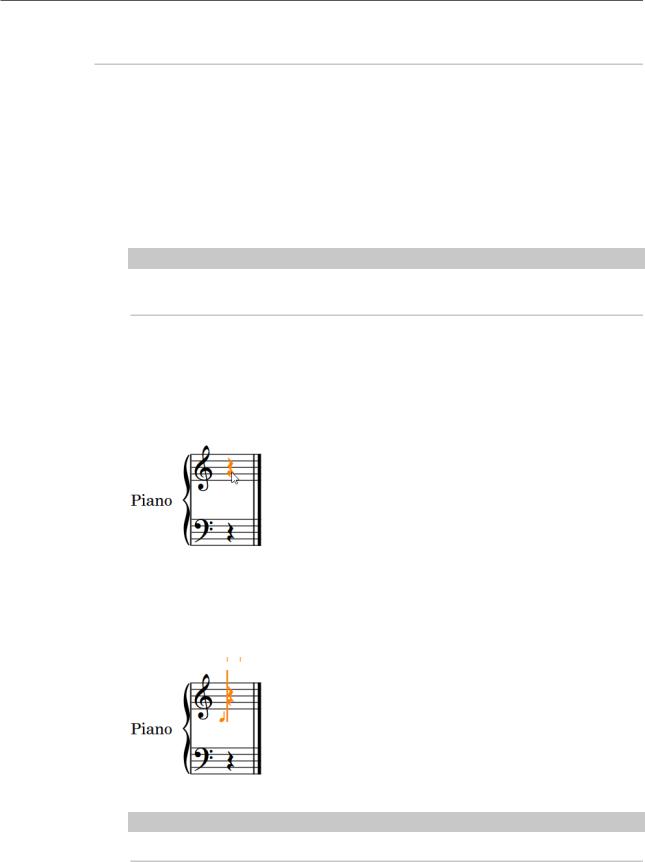
First Steps
Writing Music
have a MIDI keyboard, you can use your computer's keyboard. Of course, you can still use the mouse or touchpad if you want.
In the following sections, you learn how to input notes and notation items.
Inputting Your First Notes
In this section, you learn how to input notes. You can start inputting notes without having to first add a time signature or key signature.
PREREQUISITE
•You have set up your MIDI keyboard.
NOTE
If you have not set up a MIDI keyboard yet, you can start inputting notes with the computer keyboard.
•You have added a piano player in Setup mode.
•Write mode is active.
PROCEDURE
1.Select the rest that was automatically inserted next to the clef when you added a solo player.
2.Do one of the following:
•Press Shift-N or Return to activate note input.
•Double-click the rest.
The caret is displayed.
3.Select one of the durations on the notes panel.
NOTE
By default, Dorico selects a quarter note for you.
22

First Steps
Writing Music
4.Start playing notes on the MIDI keyboard, or press the keys A, B, C, D, E, F, G on the computer keyboard to input the corresponding pitches.
If you want higher or lower pitch for the note that Dorico inputs for you, you can force the octave above by pressing the respective key command.
RESULT
The following is an example of input notes:
RELATED LINKS
Key Commands in Dorico on page 7
Adding a Time Signature
In this section, you learn how to add a time signature at the beginning of the staff. You can add a time signature before or after inputting a melody.
PREREQUISITE
Press Esc to deactivate the caret.
PROCEDURE
1.Select the first note on the staff.
2.Press Shift-M.
This opens a small popover on top of the staff.
3.Enter a typical time signature, such as 3/4.
4.Press Enter.
23
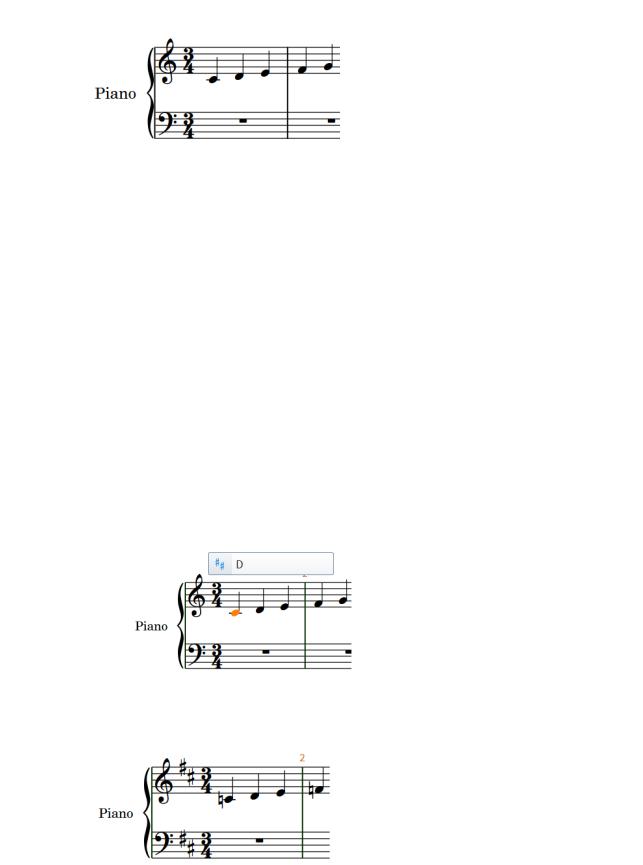
First Steps
Writing Music
RESULT
The time signature is automatically inserted to the left of the note, and the required bar lines are automatically inserted at the correct positions. If you want to insert a key signature, proceed to the next section.
Adding a Key Signature
In this section, you learn how to add a key signature. You can add a key signature at any rhythmic position on the staff.
When you start a new project from scratch, by default, there is no key signature shown. Dependent on the kind of music you are writing, the key signature might be taken to mean C major or an open key with no specific tonal center. In any case, you can change key anywhere on the staff. To add a different key signature at the beginning of the staff, for example, D major, proceed as follows:
PROCEDURE
1.Select the first note on the staff.
2.Press Shift-K.
This opens a small popover on top of the staff.
3.Enter a key signature. If you want to enter D major, enter an uppercase D. For D minor, enter a lowercase d.
4. Press Enter.
RESULT
The key signature is inserted between the clef and the time signature. Dorico automatically adds accidentals where necessary.
24
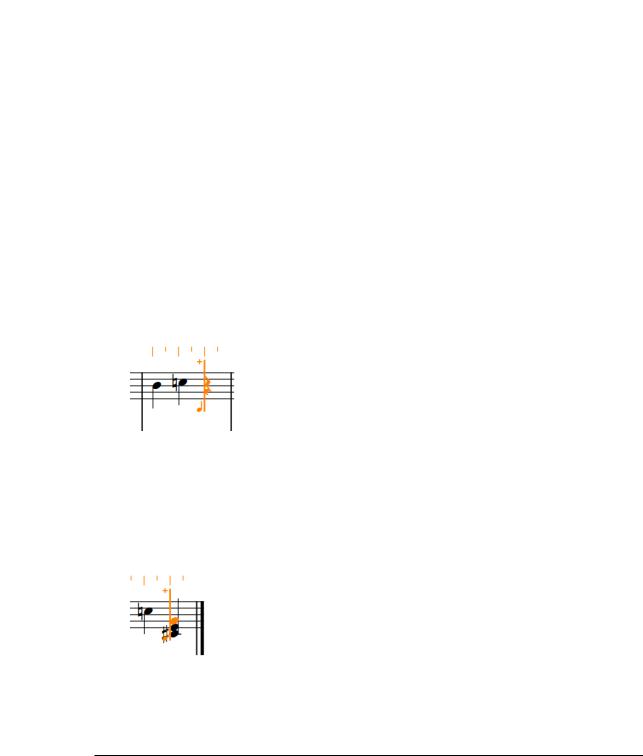
First Steps
Writing Music
Inputting Your First Chord
In this section, you learn how to input a chord with the computer keyboard, using chord mode. If you want to use a MIDI keyboard instead, you can input the chord with your keyboard, and you do not need to use chord mode. Dorico automatically inputs the correct notes for you.
PREREQUISITE
Select the last note or rest on the staff, and press Return. This shows the caret.
PROCEDURE
1.Do one of the following:
•Press Q.
•In the notes toolbox, activate Chords  . The caret now shows a plus sign at the top:
. The caret now shows a plus sign at the top:
2.Optional: Select one of the durations on the notes panel.
3.Input the notes that should form a chord by pressing keys from A to G, one after the other. For example, for a C major chord, press C, E, and G.
By default, Dorico adds each new note above the previous note. You can change the octave by pressing the respective key command.
The following example shows a possible result:
4.Press Space to advance the caret to the next note position and continue with the next chord.
Dorico expects further chord input until you deactivate it.
5.Optional: To deactivate chord input, press Q or deactivate Chords.
RELATED LINKS
Key Commands in Dorico on page 7
25

Dorico Concepts
The following sections give you an overview of the design philosophy as well as concepts on which Dorico is based.
We recommend that you familiarize yourself with these concepts as these are often returned to throughout the documentation.
Design Philosophy
If you are experienced with other scoring applications and are interested in learning more about deep design considerations for scoring programs, you may find the following discussion illuminating, but everybody can safely skip it.
Dorico has a forward-thinking design that is led by musical concepts rather than computational convenience, and this provides many benefits.
Higher-Level Concepts
In most graphically-orientated scoring applications, the highest-level concept is the staff or the instrument definition that creates a staff or staves. When setting up your full score, you start by adding the correct number of staves, and you are immediately forced into making decisions about the layout. This means that you must know in advance whether two flutes share a staff or have their own individual staves, or whether there should be two trumpets or three. Many of these decisions have significant effects throughout the process of inputting, editing, and producing individual instrumental parts.
Typically, every system of a score must contain the same number of staves, even if some are hidden on particular systems. This requires the user to manage common conventions for themselves, such as multiple players of the same instrument sharing staves. This can be time-consuming and is naturally error-prone.
Dorico is designed to conform more closely to how music is performed in the real world and to make the score a flexible expression of the practical choices that go into a musical
performance, rather than to make the musical performance subservient to the way the score was initially prepared.
To that end, the highest-level concept of Dorico is the group of human musicians that performs a score. A score can be written for one or more groups, for example, a double choir or an orchestra plus off-stage chamber ensemble, etc. Each group includes one or more players which correspond to the humans who play one or more instruments. Players may either be individuals who can play more than one instrument, for example, an oboist doubling cor anglais, or groups in which everyone plays only one instrument, for example, eight desks of violinists.
26

Dorico Concepts
Key Musical Concepts
The actual music that is played by the group in your score belongs to one or more flows. A flow is any span of music that stands alone, for example, a whole song, a movement of a sonata or symphony, a number in a musical show, or even a short scale or exercise. Players may or may not have any music to play in a given flow. For example, all the brass players may be omitted from the slow movement of a classical symphony, or certain players may have nothing to do in some cues in a movie score. This is no problem as you can combine players in flows in any combination.
Dorico provides several benefits. Chief among them is its ability to produce different score layouts that share the same musical content. For example, you can create a conductor's score with as many instruments as possible condensed onto a smaller number of staves, a full score with each player's music on separate staves, and an instrumental part containing only the music belonging to a specific player.
One crucial difference between Dorico and other scoring applications is that the musical content exists independently of the score layout in which it is viewed.
Key Musical Concepts
In order to work efficiently with Dorico, it is important to understand the conceptual model of the program.
The model is closely based on the practical considerations of how music is written and performed by real humans.
Projects
A project is an individual document that you create within Dorico.
A project may contain many separate pieces of music, from very short to very long, written for any combination of instruments and in different layouts.
Modes
Modes represent different phases in the workflow of preparing a score. In the project window, the following modes are available:
Setup
In this mode, you can set up the players and instruments that are played in the project. You can create and manage flows and set up layouts.
Write
In this mode, you can write your music. You can insert notes and rests, key signatures, time signatures, and idiomatic notations.
Engrave
In this mode, you have access to fine-grain controls that allow you to manipulate and modify every item in the project. You can also manage pages, master pages, layouts, and formats.
Play
In this mode, you can set up your project for playback. You can assign VST instruments, adjust the mix, apply automation, and optimize note data.
27

Dorico Concepts
Key Musical Concepts
In this mode, you can define different print jobs, such as printing full conductors scores, study scores, individual parts, etc. For every print job, you can specify options for page size and duplex printing. You can also manage other output, such as exports to various file types, such as PNG.
Instruments
In Dorico, an instrument is an individual musical instrument, such as a piano, a flute, or a violin.
Dorico has a database of information about properties of each instrument. These include the playable range, common and uncommon playing techniques, notational conventions, transposition properties, tunings, clef, number of staves, type of staff, etc. You can edit and extend these properties according to your needs.
NOTE
Similar instruments, such as guitars with different tunings, horns in different transpositions, or the instruments in the strings family can share common properties. This enables you to edit the data for many instruments at the same time.
RELATED LINKS
Instruments on page 63
Players
In Dorico, a player can be an individual musician or several musicians. In detail, a player may represent the following:
•A solo player, which is an individual musician who can play one or more instruments, for example, a clarinettist who doubles on alto saxophone or a percussionist who plays bass drum, clash cymbals, and triangle.
•A section player, which represents multiple musicians who all play the same instrument, for example, eight desks of violins or the soprano section in a mixed voice choir.
NOTE
Section players cannot double on different instruments, but they can play divisi. This means that they can be divided into smaller units, which is commonly required for strings.
Groups
A group represents a collection of musicians that should be considered together, such as a choir, orchestra, or a chamber ensemble.
In a typical project, there may be only one group that contains all of the defined players, but in order to allow easy separation of forces in larger-scale works, you can define as many groups as needed. It may also be necessary to assign players to these groups for the purposes of, among other things, properly bracketing and labeling their staves in the conductor's score.
28

Dorico Concepts
Key Musical Concepts
EXAMPLE
A work for double choir and organ can define the two choirs as separate groups. This allows each choir to have its own label in addition to the labels for each sectional player (soprano, alto, tenor, bass) within the choir.
In a complex work, such as Elliott Carter's “A Symphony of Three Orchestras”, each of the orchestras can be defined as a separate group.
Flows
Flows are separate spans of music that are completely independent in musical content.
A flow can be, for example, a song, a movement in a sonata or symphony, a number in a stage musical, or a short scale or sight-reading exercise of only a few bars in length. A single project can contain one or more flows.
A flow may contain music for any combination of players. For example, in a Classicalperiod symphony, it is not uncommon for the brass players to be tacet in the second, slow movement, so the flow for the second movement would simply not contain any brass players. In a set of cues for a movie, for example, specific players may not be required in particular cues, and so each flow would contain only those players who have anything to play.
NOTE
Correct assignment of players to flows allows Dorico, for example, to generate tacet sheets automatically for individual instrumental parts.
Layouts
Layouts define how music for one or more players in one or more flows is presented, including page size, margins, staff size, etc.
Layouts combine musical content that is represented by flows with rules for page layout and music engraving. You can have layouts for one or more players drawn from one or more flows. You can use the layouts to produce paginated music notation that can be printed or exported in various formats.
A typical project for an ensemble of multiple players will contain several layouts. For example, a work for string quartet in three movements contains four solo players – two violins, one viola, and one cello – and three flows, one for each movement. Such a project may require five layouts:
•Four layouts each containing the music from all three flows for one of the solo players, that is, the individual instrumental parts
•One layout containing the music from all three flows and all four players, that is, the full score
Each layout provides independent control over practically every aspect of the visual appearance of the music, including independent staff size, note spacing, and system formatting.
Each layout may also have independent page layout properties, such as page size, margins, running headers, and footers. These can be defined as master pages and then be applied freely to leftor right-hand pages or to specific pages in a layout, for example, the first or
29

Dorico Concepts
Key Musical Concepts
last page. Flow frames define where music appears on each page. To each flow frame, one or more flows is assigned in a manner analogous to how flows of text are assigned to text frames in desktop publishing applications. Dorico also provides for text frames, which allow the presentation of blocks of text, such as prefatory material, critical commentary, block lyrics, and so on.
NOTE
The page layout features of Dorico allow you to have multiple flow frames and text frames on the same page. This enables you to combine music from multiple flows on the same page.
30
